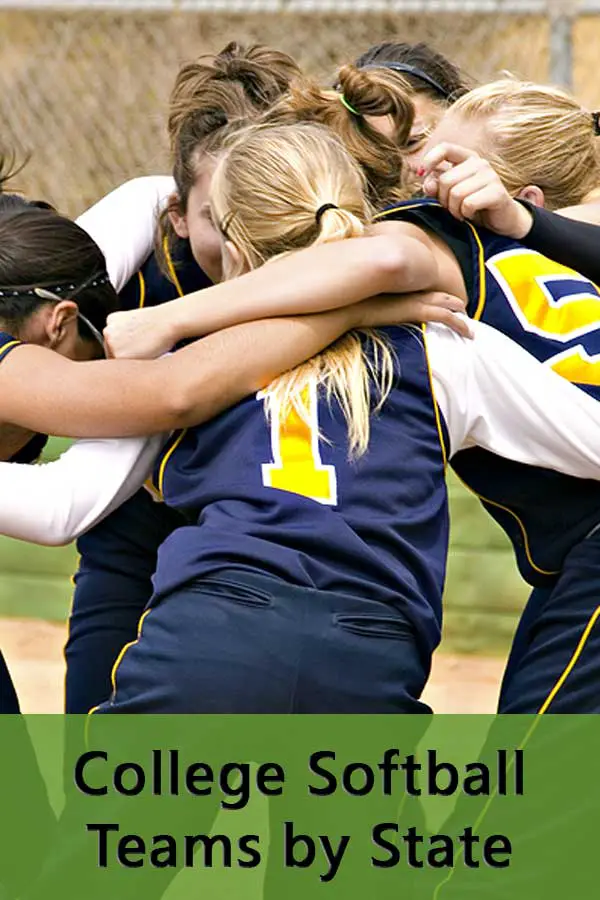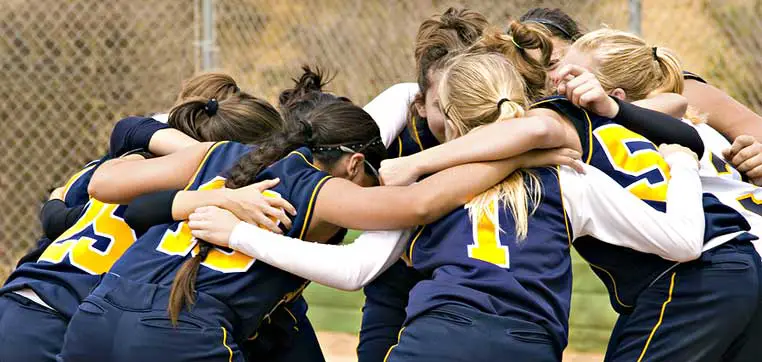 (Updated for 2022) If you want to play on a college softball team, you should probably be looking in California, Pennsylvania, or New York. However, if you’re looking specifically for Junior College teams, you should be focusing on Illinois and Texas. The states with the most D1 softball programs are California, New York, and Texas. The D3 college softball teams are concentrated in Pennsylvania, New York, and Massachusetts.
(Updated for 2022) If you want to play on a college softball team, you should probably be looking in California, Pennsylvania, or New York. However, if you’re looking specifically for Junior College teams, you should be focusing on Illinois and Texas. The states with the most D1 softball programs are California, New York, and Texas. The D3 college softball teams are concentrated in Pennsylvania, New York, and Massachusetts.
Athletes playing at the D3 level are much more likely to be at a private college than a public one. There are 316 private D3 college softball teams and only 79 public ones. However at the D1 level, the situation is reversed: there are 206 public D1 institutions and just 94 private universities (list of all D1 schools here). This is something to keep track of since D3 college softball teams don’t offer any athletic scholarships while many D1 athletes only receive partial scholarships.
Download FREE list of D1 Softball Colleges
Remember, you can improve your chances of playing college softball if you know where to look for the most appropriate level of play. This means you need to go where the teams are that are most likely to recruit you. However, be sure to take into account the supply of high school softball players in the area as well.
Below is a table listing the number of colleges in each state offering softball by the regulating organizations. You can sort the table to find out which states have the most NCAA Division 1 teams or the most Junior College teams. The total column includes all schools at all levels. All of this data can be found in the DIY College Rankings Softball Spreadsheet.
| State | NAIA | NCAA D1 | NCAA D2 | NCAA D3 | NCAA All | NCCAA | NJCAA | Other | Grand Total |
| Alabama | 4 | 10 | 7 | 2 | 19 | 14 | 1 | 38 | |
| Alaska | 0 | ||||||||
| Arizona | 3 | 3 | 3 | 13 | 19 | ||||
| Arkansas | 4 | 3 | 6 | 2 | 11 | 1 | 4 | 20 | |
| California | 10 | 21 | 17 | 8 | 46 | 84 | 140 | ||
| Canada, British Columbia | 1 | 1 | 1 | ||||||
| Colorado | 2 | 9 | 11 | 5 | 16 | ||||
| Connecticut | 7 | 4 | 7 | 18 | 18 | ||||
| Delaware | 2 | 2 | 1 | 5 | 1 | 6 | |||
| District of Columbia | 3 | 3 | 6 | 6 | |||||
| Florida | 8 | 12 | 13 | 25 | 1 | 23 | 1 | 58 | |
| Georgia | 9 | 6 | 14 | 5 | 25 | 1 | 8 | 43 | |
| Hawaii | 1 | 3 | 4 | 4 | |||||
| Idaho | 1 | 2 | 1 | 3 | 1 | 1 | 6 | ||
| Illinois | 9 | 12 | 4 | 21 | 37 | 34 | 5 | 85 | |
| Indiana | 12 | 10 | 4 | 7 | 21 | 1 | 1 | 35 | |
| Iowa | 11 | 4 | 1 | 11 | 16 | 11 | 38 | ||
| Kansas | 15 | 2 | 5 | 7 | 21 | 43 | |||
| Kentucky | 12 | 7 | 3 | 4 | 14 | 26 | |||
| Louisiana | 1 | 10 | 2 | 12 | 3 | 16 | |||
| Maine | 1 | 10 | 11 | 2 | 13 | ||||
| Maryland | 1 | 7 | 1 | 7 | 15 | 8 | 2 | 26 | |
| Massachusetts | 1 | 7 | 4 | 38 | 49 | 50 | |||
| Michigan | 10 | 6 | 6 | 8 | 20 | 17 | 1 | 48 | |
| Minnesota | 1 | 9 | 18 | 28 | 6 | 9 | 43 | ||
| Mississippi | 3 | 6 | 2 | 2 | 10 | 15 | 1 | 29 | |
| Missouri | 12 | 5 | 14 | 4 | 23 | 10 | 45 | ||
| Montana | 2 | 1 | 1 | 2 | 2 | 6 | |||
| Nebraska | 7 | 3 | 3 | 1 | 7 | 5 | 19 | ||
| Nevada | 2 | 2 | 1 | 3 | |||||
| New Hampshire | 1 | 3 | 4 | 8 | 2 | 10 | |||
| New Jersey | 7 | 4 | 15 | 26 | 5 | 6 | 37 | ||
| New Mexico | 1 | 2 | 3 | 5 | 1 | 7 | |||
| New York | 20 | 13 | 54 | 87 | 11 | 12 | 110 | ||
| North Carolina | 2 | 14 | 18 | 8 | 40 | 1 | 10 | 53 | |
| North Dakota | 4 | 2 | 2 | 4 | 4 | 12 | |||
| Ohio | 7 | 11 | 11 | 22 | 44 | 5 | 3 | 59 | |
| Oklahoma | 8 | 3 | 11 | 14 | 9 | 31 | |||
| Oregon | 6 | 3 | 2 | 5 | 10 | 6 | 22 | ||
| Pennsylvania | 2 | 12 | 22 | 58 | 92 | 6 | 12 | 112 | |
| Puerto Rico | 2 | 2 | 6 | 8 | |||||
| Rhode Island | 4 | 4 | 8 | 1 | 9 | ||||
| South Carolina | 6 | 10 | 12 | 22 | 5 | 33 | |||
| South Dakota | 4 | 2 | 4 | 6 | 10 | ||||
| Tennessee | 7 | 11 | 10 | 3 | 24 | 1 | 10 | 42 | |
| Texas | 8 | 19 | 13 | 15 | 47 | 30 | 85 | ||
| Utah | 6 | 1 | 7 | 2 | 9 | ||||
| Vermont | 1 | 4 | 5 | 5 | |||||
| Virginia | 1 | 9 | 3 | 15 | 27 | 6 | 34 | ||
| Washington | 1 | 2 | 3 | 3 | 8 | 18 | 27 | ||
| West Virginia | 1 | 1 | 14 | 1 | 16 | 1 | 18 | ||
| Wisconsin | 3 | 2 | 1 | 22 | 25 | 1 | 2 | 1 | 32 |
| Wyoming | 0 | ||||||||
| Grand Total | 196 | 297 | 287 | 394 | 978 | 6 | 310 | 175 | 1665 |
College Softball Teams Sanctioning Bodies
Keep in mind that individual conferences can have additional rules than just those required by the sanctioning body.
NAIA (National Association for Intercollegiate Athletics)
NAIA colleges can offer up to 12 softball scholarships and allow for up to two days of on campus tryouts. Prospective students must register with the NAIA Eligibility Center. Previous to COVID, students had to meet two out of three requirements to be eligible.
Starting in the Fall of 2022: “entering freshman beginning in the fall of 2022 will be able to meet initial eligibility requirements by only meeting the elevated GPA requirement of 2.300 on a 4.000 scale.” Furthermore, “students can receive an early decision of eligible based solely on their high school GPA. A student who has a 3.300 or higher after their sixth semester of high school and a student with a 2.800 or higher after their seventh semester can receive early decisions of eligible.”
There are a limited number of restrictions on contact between the coach and prospective player, generally centering on evaluations.
NCAA (National Collegiate Athletic Association)
The majority of colleges belong to the NCAA. The NCAA is divided into three divisions. Divisions 1 and 2 may offer scholarships. Division 3 schools do not offer scholarships. The NCAA is in the process of making permanent changes to its eligibility rules for Division 1 and Division 2 after COVID. Be sure to check their website for the latest requirements.
Division 1: Colleges in this division may offer up to 12 equivalency softball scholarships. Pay close attention to the eligibility requirements in the Guide for the College-Bound Student-Athlete. Prospective players must register with the NCAA eligibility center. For the coming academic year, the NCAA states that:
student-athletes enrolling in a Division I school during the 2022-23 academic year will be academically eligible by earning a 2.3 grade-point average in 16 NCAA-approved core courses, with 10 core courses (seven in English, math and science) completed by the start of their seventh semester in high school (before senior year).
Division 2: Colleges in this division may offer up to 7.2 equivalency softball scholarships. Academic eligibility requirements are less complicated than D1 and there are fewer restrictions in terms of amateur status. As in the case for Division, the NCAA is revising its eligibility rules for Division 2. For the coming academic year, “Student-athletes enrolling in a Division II school during the 2021-22 or 2022-23 academic year will be academically eligible by earning a 2.2 grade-point average in 16 NCAA-approved core courses.” Check with the NCAA for the latest rule changes.
Division 2 is the only one that allows college softball teams to offer tryouts for prospective students. Pay close attention to the eligibility requirements in the Guide for the College-Bound Student-Athlete. Prospective students for Division 2 colleges must register with the NCAA eligibility center.
Division 3: Colleges in this division do not offer any athletic scholarships. Rules for recruiting and eligibility are determined by individual conferences. Prospective players do not have to register with the NCAA Eligibility center.
This is the largest of the three divisions which spans the talent spectrum. This division also contains the majority of academically demanding schools (exceptions include the Ivy League and Stanford) where being recruited by the softball coach may help your chances for admission.
NCCAA (National Christian College Athletic Association)
The NCCAA consists of primarily bible colleges and small Christian colleges and is divided into two divisions. Division 1 colleges may offer up to 12 softball scholarships. Division 2 colleges are not allowed to offer any athletic scholarships. Check with the NCCAA for any changes regarding eligibility requirements. Entering freshman are required to meet two of the following three requirements to participate in athletics:
- Minimum score of 18 on the ACT or 860 on the SAT
- Minimum GPA of 2.0 on a 4.0 scale
- Top half of high school graduating class
NJCAA (National Junior College Athletic Association)
The NJCAA consists of 3 divisions with only divisions 1 and 2 offering up to 24 scholarships. These are generally two-year programs with an occasional school offering some four-year programs. As for eligibility, you need a high school diploma and then according to the NJCAA website:
Due to the unique academic and athletic situation of each individual, and the complexity of the NJCAA eligibility rules, it is recommended that each potential student-athlete discuss their athletic eligibility with the athletic personnel at the NJCAA college where they have chosen to attend.
CONNECT WITH OTHER PARENTS WITH PROSPECTIVE COLLEGE ATHLETES
JOIN THE COLLEGE RECRUITING PARENT ZONE



2 thoughts on “College Softball Teams by State”